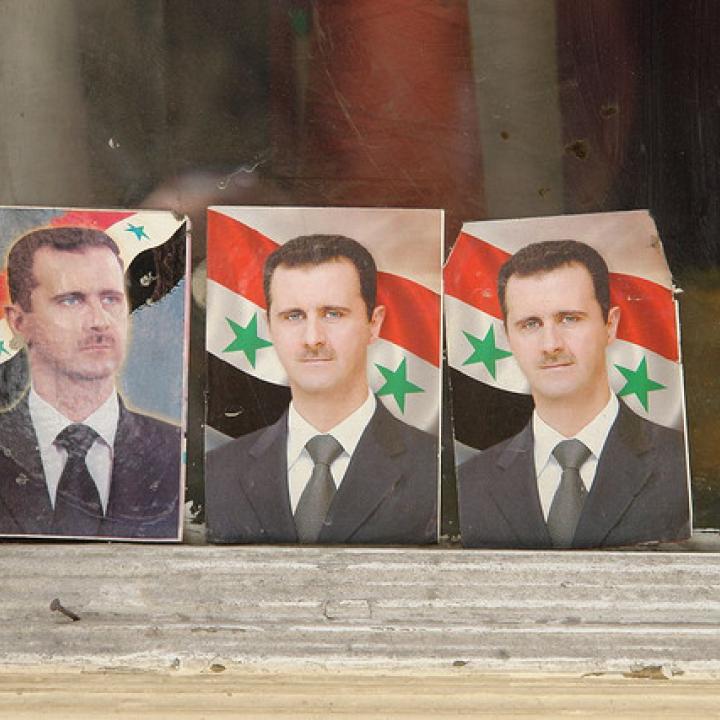
- Policy Analysis
- PolicyWatch 3142
Assad's Thinking: How Did Syria Get Here, and Where Does the Regime Want to Go Now?

Former American and French ambassadors discuss the regime's calculus and preview the upcoming U.S.-Russia summit in Jerusalem. Watch video or read a summary.
On June 18, Michel Duclos and Robert Ford addressed a Policy Forum at The Washington Institute. Duclos is a former French ambassador to Syria (2006-2009), a special advisor to Institut Montaigne, and author of the new book La Longue Nuit Syrienne. Ford, the U.S. ambassador to Syria from 2011 to 2014, is a senior fellow at the Middle East Institute and the Jackson Institute for Global Affairs. The following is a rapporteur’s summary of their remarks.
MICHEL DUCLOS
To understand what is going on in Syria today, one must first diagnose the conflict’s root causes. Bashar al-Assad’s regime, at its foundation, uses violence and sectarian minority power to maintain its rule, adjusting to new circumstances as needed. Real power remains concentrated in the hands of his family, while the Baath Party has nearly vanished and the military’s role in governance continues to decrease. In their place, the regime has focused on strengthening the crony capitalist system, the intelligence services, and the prison system.
Even so, the regime still has to deal with issues of legitimacy. Believing that Syria’s Sunni Muslim majority population will never accept Assad’s rule, he and his circle have focused on maintaining power by force and suppression. The need for legitimacy also helps explain why he feels compelled to retake more of the territory lost during the war; this is why he is desperate to retake Idlib province with Russia’s help.
Assad’s increasing reliance on Russia—along with Iran and Hezbollah—has other implications as well. Moscow and Tehran share many common interests in Syria, and the Kremlin relies on Iranian-backed Shia militias to maintain stability there. The two countries might disagree over Syria’s future, but they are unlikely to jeopardize their relationship for the time being.
In particular, Moscow fears that uncontrolled escalation between Iran and Israel might endanger Syria’s stability. To keep such confrontations manageable, Vladimir Putin has taken two key steps: allowing Israel to take occasional action against Iranian military expansion in Syria, and rebuilding the Syrian army in order to end Assad’s dependence on Iran and its proxies. As for the upcoming U.S.-Russia negotiations in Jerusalem, Moscow will likely demand American normalization with Damascus in exchange for Russian promises to deal with Iran’s presence in the future.
Regarding reconstruction, the current situation in Syria makes it difficult for the West to be involved in any such initiatives there. The West’s lack of response to Assad’s abuses earlier in the war taught the regime there was no limit to what it could get away with, while also pushing it further into the Russian-Iranian camp. The United States and other governments will therefore need to exercise patience going forward. The presence of U.S. forces in northeast Syria has yielded positive results in countering the Islamic State; in the future, this same presence would give Washington a local military advantage and help mediate tensions between Turkey and the Syrian Kurds.
ROBERT FORD
Since the war began, there has been an effort to change the narrative regarding Syria’s popular protest movement. For the most part, this movement was peaceful all across the country. The protestors’ main demands at the outset focused on holding the intelligence services more accountable for their actions, not forcing Assad to step down. Yet the regime opposed any accountability or power sharing and responded to demonstrators with force, relying on violence to retain power ever since.
In 2017, Assad commented that his dream was to create a more homogeneous Syria. He does not support the return of refugees and has taken steps to ensure they do not reenter the country. The regime also continues to eliminate opposition groups and reclaim territory without accounting for local economic grievances or future reconstruction plans. Meanwhile, Assad has been granting favors to a small class of business elites who support the crony capitalist system. Taken together, these tactics have largely destroyed Syria’s middle class.
Regarding Russia, Moscow’s core goal in Syria is ensuring the state’s survival. Putin understands that he is competing with Tehran there but has been careful in how he pushes back against the Iranian presence. This is partly why he asked Israel to limit the extent of its targeting in Syria.
As for the Jerusalem summit, Russia will likely reject any U.S.-Israeli requests for Iran-related concessions that undermine Moscow’s own presence in the region. Instead, Putin will probably demand heavy concessions from U.S. and Israeli officials in return for promises of eventually containing Iranian activities in Syria. So far, it remains unclear what sort of concessions Washington is willing to make. Whatever the case, U.S. officials need to understand that Russia and Iran share the goal of reducing American influence in the Middle East. Although attempting to drive a wedge between them may lead to short-term tactical successes, it is unlikely to yield significant results in the long term.
Finally, the current U.S. Congress has made clear that it will not support any reconstruction efforts in parts of Syria that are under Assad’s control. This stance is compounded by the fact that Syrian national reconciliation remains highly unlikely, since the regime is bent on ruling through intimidation and coercion.
This summary was prepared by Zied Bouchlaghem.




